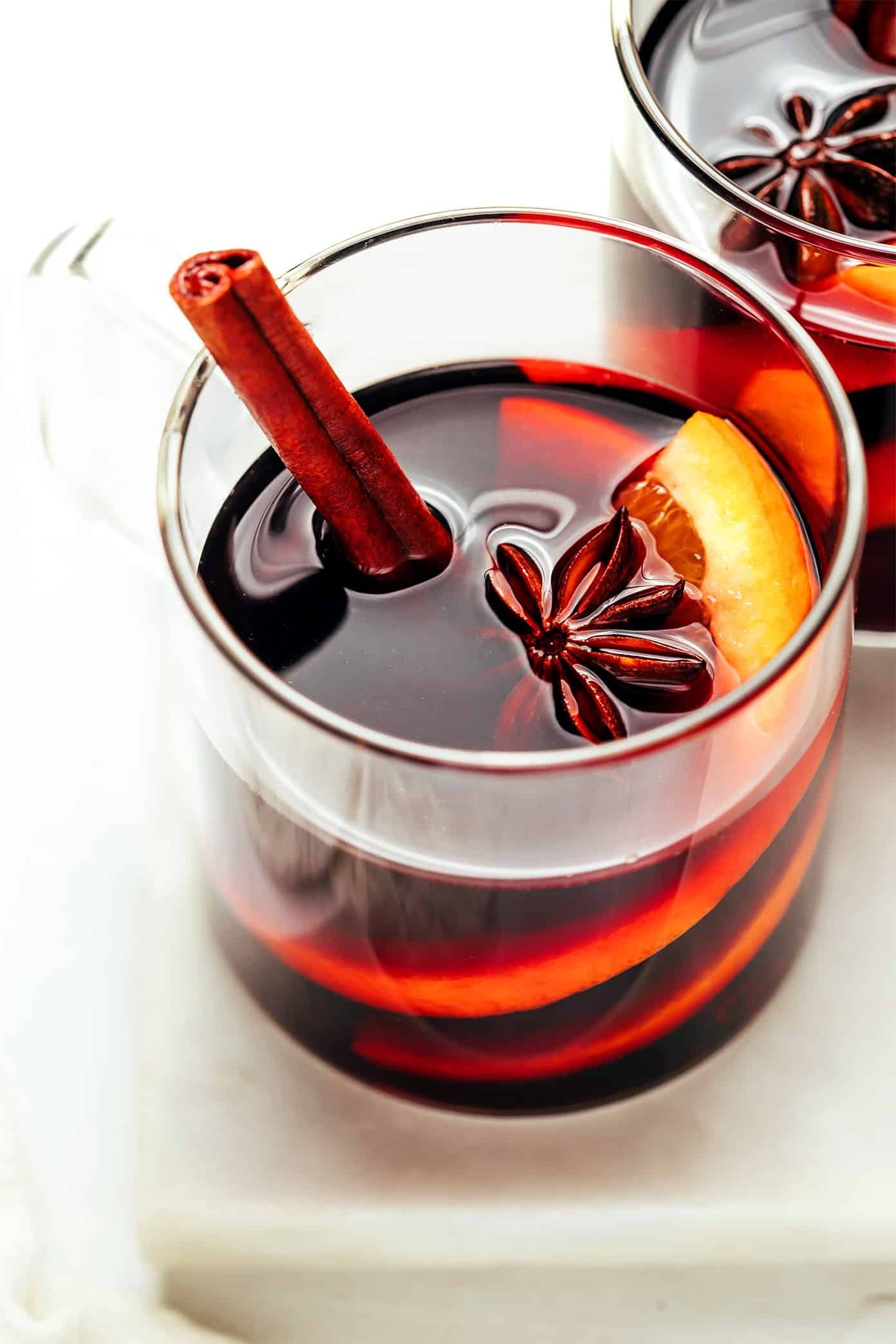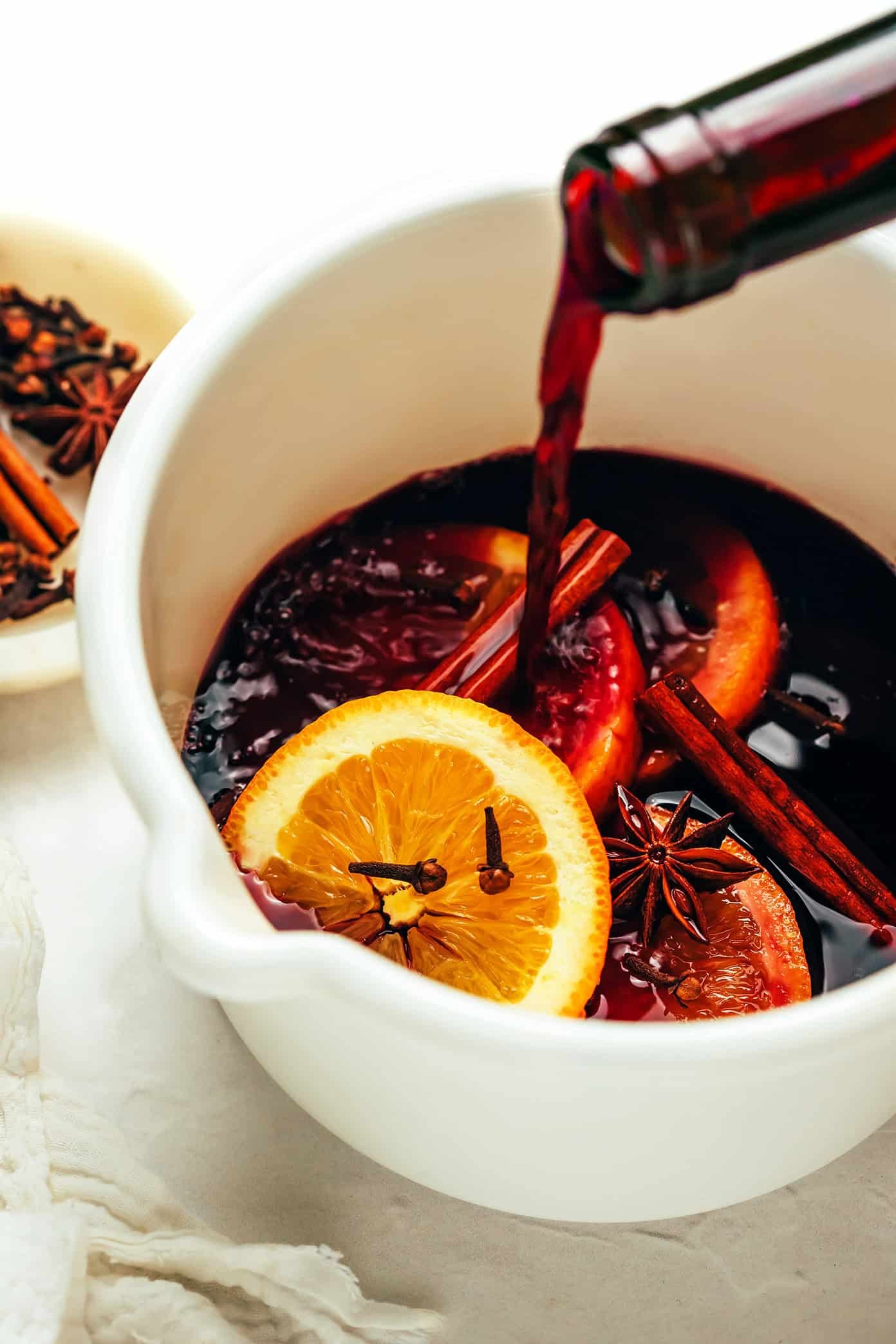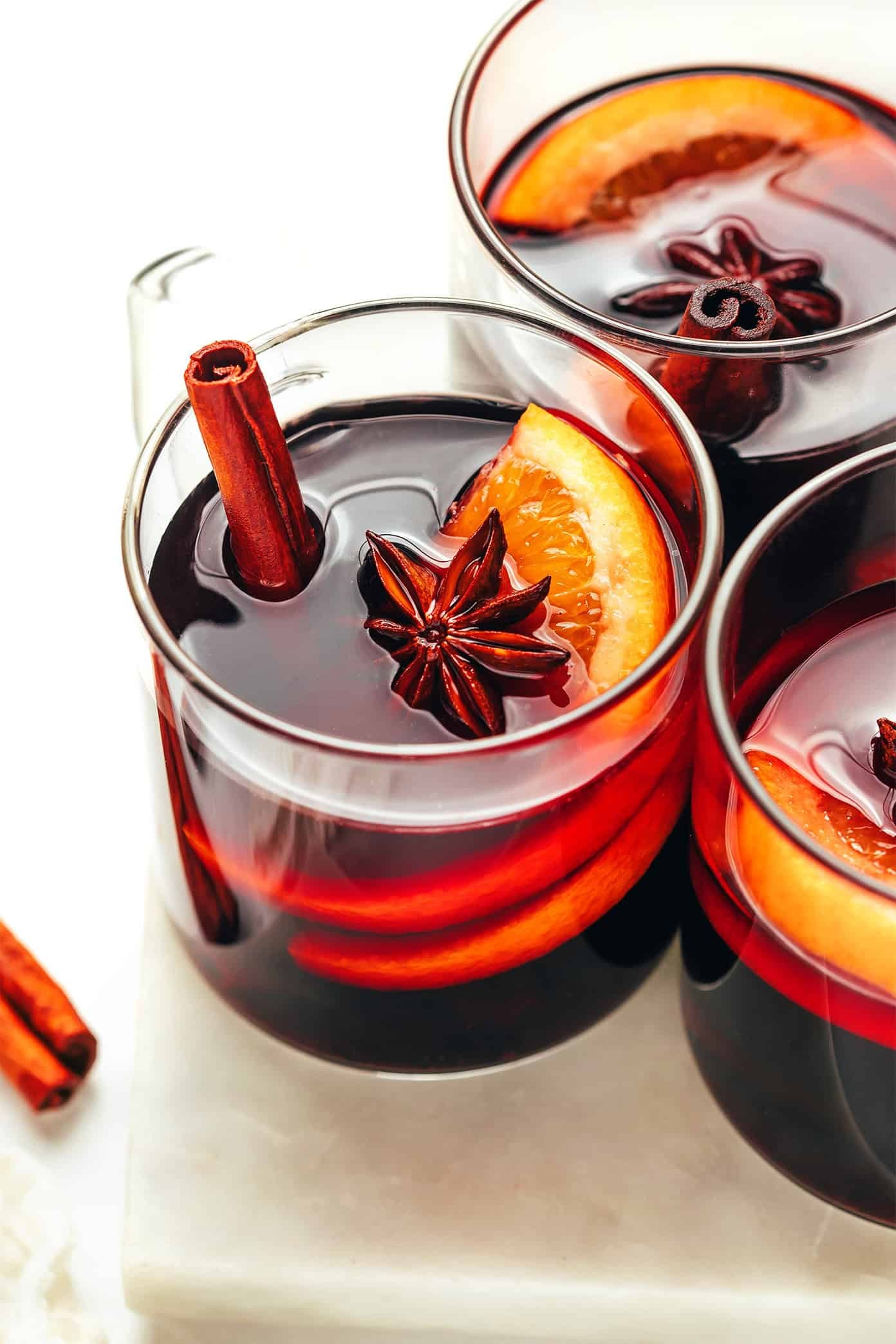What Is Mulled Wine? It’s a warm, spiced alcoholic beverage, especially popular during the colder months. At WHAT.EDU.VN, we offer free answers to all your questions, including everything you need to know about this festive drink, also known as spiced wine, glühwein or Christmas wine. Discover the history, ingredients, variations, and how to make your own delicious batch. Whether you’re curious about wine infusions, holiday drinks, or comforting winter beverages, our platform provides quick and easy access to reliable information.
1. Discovering the Warm Embrace: What is Mulled Wine?
Mulled wine, a beloved beverage across cultures, brings warmth and cheer to chilly evenings. More than just heated wine, it’s a carefully crafted infusion of spices, fruits, and sometimes a touch of spirits. The beauty of mulled wine lies in its simplicity and versatility, making it a perfect choice for both casual gatherings and festive celebrations.
Understanding the Essence of Mulled Wine
Mulled wine is essentially wine that has been heated and flavored with various spices and fruits. The process of “mulling” refers to infusing the wine with these aromatic ingredients, creating a drink that is both comforting and flavorful. The exact blend of spices can vary widely, reflecting local traditions and personal preferences, offering a unique taste experience with every sip.
Delving into the History of Mulled Wine
The tradition of mulling wine dates back to ancient times, with evidence suggesting that the Romans heated and spiced wine to preserve it and make it more palatable. As the Roman Empire expanded, so did the practice of mulling wine, eventually spreading throughout Europe. In the Middle Ages, mulled wine became a popular beverage during winter festivals and celebrations, often associated with warmth, hospitality, and good cheer. Today, mulled wine remains a cherished tradition, enjoyed in homes, pubs, and Christmas markets around the world.
Navigating the Global Landscape of Mulled Wine
Mulled wine goes by many names and variations depending on the region. In Germany, it’s known as Glühwein, while in Scandinavia, it’s called Glögg. France boasts Vin Chaud, and Italy offers Vin Brulé. Each country adds its own unique twist to the recipe, incorporating local spices, fruits, and spirits. Exploring these regional variations is a delicious way to experience the diverse culinary traditions of the world.
2. Uncorking the Secrets: Essential Mulled Wine Ingredients
Creating the perfect mulled wine involves selecting the right ingredients and combining them in a way that enhances the flavors. While specific recipes may vary, certain ingredients are essential to achieving that classic mulled wine taste.
The Foundation: Choosing the Right Wine
The wine serves as the base for mulled wine, so selecting a suitable variety is crucial. A dry red wine is the most common choice, but white wine can also be used. Fruity and full-bodied wines like Zinfandel, Merlot, Grenache, Cabernet Sauvignon, or Syrah are excellent options. Avoid wines that are too tannic or acidic, as these qualities can become amplified when heated. There’s no need to use an expensive bottle, a mid-range wine will work perfectly well. Boxed wine is also a cost-effective option when making larger batches.
The Aromatic Ensemble: Spices That Define Mulled Wine
Spices are the heart and soul of mulled wine, infusing the drink with warmth, complexity, and festive aromas. The most common spices include cinnamon sticks, whole cloves, and star anise. Other popular choices include cardamom pods, nutmeg, allspice, and fresh ginger. The key is to use whole spices rather than ground spices, as they provide a cleaner flavor and are easier to remove after mulling.
The Sweet Symphony: Balancing Flavors with Sweeteners
Sweeteners play a crucial role in balancing the flavors of mulled wine, adding a touch of sweetness to complement the spices and fruits. White sugar, brown sugar, honey, and maple syrup are all excellent choices. The amount of sweetener needed will depend on the sweetness of the wine and your personal preference. Start with a small amount and add more to taste.
The Zesty Zing: Adding Citrus and Fruits
Citrus fruits add a bright, refreshing element to mulled wine, enhancing the overall flavor profile. Oranges are the most common choice, but lemons, limes, and grapefruits can also be used. The citrus fruits can be sliced into rounds or zested, adding both flavor and visual appeal. Other fruits like cranberries, apples, and pears can also be added for extra depth and complexity.
The Spirited Kick: Enhancing with Liqueurs (Optional)
For an extra kick, consider adding a splash of liqueur to your mulled wine. Brandy is the traditional choice, but orange liqueurs like Cointreau or Grand Marnier are also delicious options. Tawny port is another popular choice, adding a rich, nutty flavor. The amount of liqueur added will depend on your personal preference and the desired level of potency.
3. Crafting Your Cozy Concoction: How to Make Mulled Wine
Making mulled wine at home is a simple and rewarding process. With just a few basic ingredients and a little bit of time, you can create a delicious and comforting beverage that is perfect for any occasion.
Step-by-Step Guide to Making Mulled Wine
- Combine Ingredients: In a large saucepan or pot, combine the wine, spices, citrus fruits, and sweetener.
- Simmer Gently: Heat the mixture over medium-low heat, being careful not to boil. Simmer gently for at least 15 minutes, or up to 3 hours, allowing the flavors to meld together. The longer it simmers, the more flavorful it will become.
- Strain and Serve: Remove the mixture from the heat and strain out the spices and citrus fruits using a fine-mesh strainer or cheesecloth. Taste and add more sweetener if needed. Serve warm in mugs or heatproof glasses.
Tips and Tricks for the Perfect Mulled Wine
- Don’t Boil: Avoid boiling the wine, as this can cause the alcohol to evaporate and the flavors to become bitter.
- Use Whole Spices: Whole spices provide a cleaner flavor and are easier to remove after mulling.
- Simmer Slowly: Simmering the wine slowly allows the flavors to meld together and create a more complex and nuanced beverage.
- Adjust Sweetness: Adjust the amount of sweetener to your personal preference, starting with a small amount and adding more to taste.
- Garnish Generously: Garnish your mulled wine with citrus slices, cinnamon sticks, star anise, or fresh cranberries for a festive touch.
Exploring Variations: White Mulled Wine and Beyond
While red wine is the traditional choice for mulled wine, white wine can also be used. Choose a dry white wine like Chardonnay, Pinot Grigio, or Sauvignon Blanc. The spices and fruits can be adjusted to complement the flavors of the white wine. For example, you might use lemon and ginger instead of orange and cinnamon. You can also experiment with other variations, such as adding chai tea bags for a spiced tea flavor or incorporating different fruits like apples or pears.
4. Global Variations of Mulled Wine: A Taste of Tradition
Mulled wine is a global beverage with countless variations, each reflecting the unique culinary traditions of its region. Exploring these variations is a delicious way to experience the diverse flavors of the world.
Glühwein: Germany’s Festive Favorite
Glühwein, meaning “glow wine” in German, is a staple of German Christmas markets. It is typically made with red wine, cinnamon sticks, cloves, star anise, citrus fruits, and sugar. Some recipes also include vanilla extract or rum. Glühwein is often served in ceramic mugs adorned with festive designs, making it a cherished souvenir of the Christmas market experience.
Glögg: Scandinavia’s Spicy Sensation
Glögg is a Scandinavian mulled wine that is often enjoyed during the Christmas season. It is typically made with red wine, spices like cardamom, ginger, and cloves, citrus fruits, and sugar. Glögg often includes a splash of aquavit, vodka, or brandy for an extra kick. It is traditionally served with raisins and blanched almonds.
Vin Chaud: France’s Warm Embrace
Vin Chaud, meaning “hot wine” in French, is a simple and comforting beverage that is often enjoyed during the winter months. It is typically made with red wine, cinnamon sticks, cloves, citrus fruits, and sugar. Some recipes also include a splash of brandy or cognac. Vin Chaud is often served in ski resorts and cozy cafes.
Vin Brulé: Italy’s Fiery Elixir
Vin Brulé, meaning “burnt wine” in Italian, is a mulled wine that is often enjoyed during winter festivals and celebrations. It is typically made with red wine, cinnamon sticks, cloves, citrus fruits, and sugar. The mixture is often flambéed before serving, giving it a smoky flavor.
Exploring Other Regional Variations
Mulled wine is enjoyed in countless other countries and regions, each with its own unique variations. In Eastern Europe, mulled wine is often made with honey and spices like cardamom and allspice. In South America, it is often made with red wine, cinnamon, cloves, and panela (unrefined whole cane sugar). Exploring these regional variations is a delicious way to expand your culinary horizons.
5. The Health Benefits of Mulled Wine: Sip with Satisfaction
While mulled wine is often enjoyed for its delicious flavor and comforting warmth, it also offers several potential health benefits.
Antioxidant Powerhouse: The Role of Wine and Spices
Red wine is rich in antioxidants, which can help protect the body against damage from free radicals. The spices used in mulled wine, such as cinnamon, cloves, and star anise, also contain antioxidants and anti-inflammatory compounds. These compounds may help boost the immune system, reduce inflammation, and protect against chronic diseases.
Warmth and Comfort: Soothing Sore Throats and Colds
The warmth of mulled wine can help soothe sore throats and ease cold symptoms. The spices can also help clear congestion and promote relaxation. However, it is important to drink mulled wine in moderation, as excessive alcohol consumption can weaken the immune system.
Mental Well-being: Relaxation and Stress Relief
Enjoying a warm mug of mulled wine can be a relaxing and enjoyable experience, helping to reduce stress and promote mental well-being. The aromatic spices can also have a calming effect on the mind. However, it is important to be mindful of your alcohol consumption and avoid overindulging.
Moderation is Key: Responsible Enjoyment of Mulled Wine
While mulled wine offers several potential health benefits, it is important to drink it in moderation. Excessive alcohol consumption can have negative health consequences. The recommended daily limit for alcohol consumption is one drink per day for women and two drinks per day for men. It is also important to avoid drinking alcohol if you are pregnant, breastfeeding, or taking certain medications.
6. Pairing Mulled Wine: Enhancing the Experience
Mulled wine is a versatile beverage that pairs well with a variety of foods. The key is to choose foods that complement the warm, spicy flavors of the wine.
Savory Sensations: Cheese, Charcuterie, and More
Mulled wine pairs well with savory appetizers like cheese and charcuterie. Hard cheeses like cheddar, gouda, and parmesan are excellent choices. Cured meats like salami, prosciutto, and chorizo also complement the flavors of mulled wine. Other savory options include olives, nuts, and crackers.
Sweet Treats: Cookies, Cakes, and Festive Desserts
Mulled wine also pairs well with sweet treats like cookies, cakes, and festive desserts. Gingerbread cookies, spice cakes, and fruit pies are all excellent choices. Chocolate desserts can also be a good pairing, especially dark chocolate with nuts or dried fruits.
Complete Meals: Hearty Dishes for Winter Evenings
For a complete meal, mulled wine pairs well with hearty dishes like stews, roasts, and casseroles. The warm, spicy flavors of the wine complement the rich, savory flavors of these dishes. Consider pairing mulled wine with a beef stew, a roasted chicken, or a vegetable casserole.
Creative Combinations: Exploring Unique Pairings
Don’t be afraid to experiment with different food pairings to find your perfect combination. Consider pairing mulled wine with spicy Asian dishes, savory pastries, or even grilled meats. The possibilities are endless.
7. Mulled Wine Cocktails: Adding a Twist to Tradition
For those looking to add a twist to the classic mulled wine recipe, there are countless cocktail variations to explore.
Spiked Cider: A Fruity Fusion
Combine mulled wine with apple cider for a fruity and flavorful cocktail. The apple cider adds a touch of sweetness and acidity, complementing the warm spices of the mulled wine. Garnish with apple slices and cinnamon sticks.
Mulled Wine Sangria: A Festive Blend
Combine mulled wine with red wine, brandy, and chopped fruits like oranges, apples, and cranberries for a festive sangria. The fruits add extra flavor and visual appeal. Serve chilled or over ice.
Mulled Wine Margarita: A Spicy Kick
Combine mulled wine with tequila, lime juice, and agave nectar for a spicy margarita. The mulled wine adds a warm, spicy flavor that complements the tequila and lime. Rim the glass with salt or sugar.
Non-Alcoholic Options: Mulled Mocktails for Everyone
For those who prefer non-alcoholic options, mulled wine can be easily adapted into a mocktail. Simply replace the wine with grape juice, apple cider, or cranberry juice. Add the same spices and citrus fruits as in the traditional recipe.
8. Storing and Reheating Mulled Wine: Keeping the Warmth Alive
Proper storage and reheating techniques are essential to preserving the flavor and quality of mulled wine.
Storage Solutions: Keeping it Fresh
Store leftover mulled wine in an airtight container in the refrigerator for up to 3 days. This will help prevent the wine from oxidizing and losing its flavor.
Reheating Methods: Restoring the Warmth
Reheat mulled wine gently over low heat on the stovetop, being careful not to boil. You can also reheat it in a slow cooker on low heat. Avoid using the microwave, as this can cause the wine to become overheated and lose its flavor.
Enhancing Flavor: Adding Fresh Ingredients
When reheating mulled wine, consider adding fresh citrus slices or spices to enhance the flavor. This will help restore the aroma and complexity of the drink.
Freezing for Later: A Convenient Option
Mulled wine can also be frozen for later use. Pour the wine into freezer-safe containers, leaving some space at the top to allow for expansion. Thaw the wine in the refrigerator overnight before reheating.
9. Frequently Asked Questions About Mulled Wine
Here are some frequently asked questions about mulled wine:
| Question | Answer |
|---|---|
| What is the best wine to use for mulled wine? | A dry red wine like Merlot, Zinfandel, or Cabernet Sauvignon is recommended. |
| Can I use white wine for mulled wine? | Yes, a dry white wine like Chardonnay or Pinot Grigio can be used. |
| What spices are typically used in mulled wine? | Cinnamon sticks, cloves, and star anise are the most common spices. |
| How long can I store mulled wine? | Mulled wine can be stored in the refrigerator for up to 3 days. |
| Can I freeze mulled wine? | Yes, mulled wine can be frozen for later use. |
| What foods pair well with mulled wine? | Cheese, charcuterie, cookies, cakes, and hearty dishes like stews and roasts all pair well with mulled wine. |
| Can I make mulled wine without alcohol? | Yes, simply replace the wine with grape juice, apple cider, or cranberry juice. |
| How do I prevent mulled wine from boiling? | Heat the wine over low heat and simmer gently, being careful not to boil. |
| Can I add other fruits to mulled wine? | Yes, oranges, lemons, limes, cranberries, apples, and pears can all be added to mulled wine. |
| What is the origin of mulled wine? | The tradition of mulling wine dates back to ancient times, with evidence suggesting that the Romans heated and spiced wine to preserve it and make it more palatable. |



10. Where to Find More Answers: WHAT.EDU.VN is Here to Help
Still have questions about mulled wine or any other topic? WHAT.EDU.VN is your go-to resource for free answers to all your queries. Our platform offers a vast database of information, covering a wide range of subjects. Whether you’re a student, a professional, or simply a curious individual, WHAT.EDU.VN is here to provide you with the knowledge you need. Don’t hesitate to ask us anything!
Do you have more questions about mulled wine or other topics? Visit WHAT.EDU.VN today to ask your questions and receive free answers from our community of experts. We’re here to help you find the information you need, quickly and easily. Contact us at 888 Question City Plaza, Seattle, WA 98101, United States, or reach out via Whatsapp at +1 (206) 555-7890. Your quest for knowledge starts at what.edu.vn!